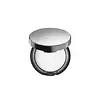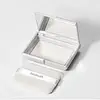What's inside
What's inside
 Key Ingredients
Key Ingredients

 Benefits
Benefits

 Concerns
Concerns

 Ingredients Side-by-side
Ingredients Side-by-side

Talc
AbrasiveCaprylic/Capric Triglyceride
MaskingSilica
AbrasiveMethyl Methacrylate Crosspolymer
Mica
Cosmetic ColorantDimethicone
EmollientNylon-12
Triethylhexanoin
MaskingBoron Nitride
AbsorbentSynthetic Beeswax
Emulsion StabilisingDiisostearyl Malate
EmollientGlyceryl Caprylate
EmollientEthylhexylglycerin
Skin ConditioningAllantoin
Skin ConditioningPropanediol
SolventPentylene Glycol
Skin ConditioningTocopheryl Acetate
AntioxidantPinus Sylvestris Leaf Extract
TonicCocos Nucifera Fruit Extract
EmollientWater
Skin ConditioningButylene Glycol
Humectant1,2-Hexanediol
Skin ConditioningSodium Hyaluronate
HumectantHydroxyacetophenone
AntioxidantHyaluronic Acid
HumectantSodium Acetylated Hyaluronate
HumectantHydrolyzed Hyaluronic Acid
HumectantHydrolyzed Sodium Hyaluronate
Skin ConditioningTalc, Caprylic/Capric Triglyceride, Silica, Methyl Methacrylate Crosspolymer, Mica, Dimethicone, Nylon-12, Triethylhexanoin, Boron Nitride, Synthetic Beeswax, Diisostearyl Malate, Glyceryl Caprylate, Ethylhexylglycerin, Allantoin, Propanediol, Pentylene Glycol, Tocopheryl Acetate, Pinus Sylvestris Leaf Extract, Cocos Nucifera Fruit Extract, Water, Butylene Glycol, 1,2-Hexanediol, Sodium Hyaluronate, Hydroxyacetophenone, Hyaluronic Acid, Sodium Acetylated Hyaluronate, Hydrolyzed Hyaluronic Acid, Hydrolyzed Sodium Hyaluronate
Mica
Cosmetic ColorantSynthetic Fluorphlogopite
Silica
AbrasiveDimethicone
EmollientMacadamia Ternifolia Seed Oil
EmollientHdi/PPG/Polycaprolactone Crosspolymer
Magnesium Myristate
Glycerin
HumectantIsopropyl Palmitate
EmollientMoringa Oleifera Seed Oil
EmollientButyrospermum Parkii Butter
Skin ConditioningEnantia Chlorantha Bark Extract
Skin ConditioningPearl Extract
AntioxidantCandida Bombicola/Glucose/Methyl Rapeseedate Ferment
AntimicrobialDiamond Powder
AbrasiveTriethoxycaprylylsilane
Pentylene Glycol
Skin ConditioningPolysorbate 20
EmulsifyingOctyldodecyl Stearoyl Stearate
EmollientAcrylamide/Sodium Acryloyldimethyltaurate Copolymer
Emulsion StabilisingHydrogen Dimethicone
Magnesium Aluminum Silicate
AbsorbentSorbitan Olivate
EmulsifyingSorbitan Stearate
EmulsifyingIsohexadecane
EmollientEthylhexylglycerin
Skin ConditioningPolysorbate 80
EmulsifyingSorbitan Oleate
EmulsifyingPolymethylsilsesquioxane
Butylene Glycol
HumectantPropylene Glycol
HumectantOctyldodecanol
EmollientTocopherol
AntioxidantCeramide NP
Skin ConditioningPhytosphingosine
Skin ConditioningHydrogenated Lecithin
EmulsifyingGlycine Soja Sterols
EmollientOleanolic Acid
Skin ConditioningOleyl Alcohol
EmollientSodium Dehydroacetate
PreservativePhenoxyethanol
PreservativePotassium Sorbate
PreservativeParfum
MaskingMica, Synthetic Fluorphlogopite, Silica, Dimethicone, Macadamia Ternifolia Seed Oil, Hdi/PPG/Polycaprolactone Crosspolymer, Magnesium Myristate, Glycerin, Isopropyl Palmitate, Moringa Oleifera Seed Oil, Butyrospermum Parkii Butter, Enantia Chlorantha Bark Extract, Pearl Extract, Candida Bombicola/Glucose/Methyl Rapeseedate Ferment, Diamond Powder, Triethoxycaprylylsilane, Pentylene Glycol, Polysorbate 20, Octyldodecyl Stearoyl Stearate, Acrylamide/Sodium Acryloyldimethyltaurate Copolymer, Hydrogen Dimethicone, Magnesium Aluminum Silicate, Sorbitan Olivate, Sorbitan Stearate, Isohexadecane, Ethylhexylglycerin, Polysorbate 80, Sorbitan Oleate, Polymethylsilsesquioxane, Butylene Glycol, Propylene Glycol, Octyldodecanol, Tocopherol, Ceramide NP, Phytosphingosine, Hydrogenated Lecithin, Glycine Soja Sterols, Oleanolic Acid, Oleyl Alcohol, Sodium Dehydroacetate, Phenoxyethanol, Potassium Sorbate, Parfum
Ingredients Explained
These ingredients are found in both products.
Ingredients higher up in an ingredient list are typically present in a larger amount.
Butylene Glycol (or BG) is used within cosmetic products for a few different reasons:
Overall, Butylene Glycol is a safe and well-rounded ingredient that works well with other ingredients.
Though this ingredient works well with most skin types, some people with sensitive skin may experience a reaction such as allergic rashes, closed comedones, or itchiness.
Learn more about Butylene GlycolDimethicone is a type of synthetic silicone created from natural materials such as quartz.
What it does:
Dimethicone comes in different viscosities:
Depending on the viscosity, dimethicone has different properties.
Ingredients lists don't always show which type is used, so we recommend reaching out to the brand if you have questions about the viscosity.
This ingredient is unlikely to cause irritation because it does not get absorbed into skin. However, people with silicone allergies should be careful about using this ingredient.
Note: Dimethicone may contribute to pilling. This is because it is not oil or water soluble, so pilling may occur when layered with products. When mixed with heavy oils in a formula, the outcome is also quite greasy.
Learn more about DimethiconeEthylhexylglycerin (we can't pronounce this either) is commonly used as a preservative and skin softener. It is derived from glyceryl.
You might see Ethylhexylglycerin often paired with other preservatives such as phenoxyethanol. Ethylhexylglycerin has been found to increase the effectiveness of these other preservatives.
Mica is a naturally occurring mineral used to add shimmer and color in cosmetics. It can also help improve the texture of a product or give it an opaque, white/silver color.
Serecite is the name for very fine but ragged grains of mica.
This ingredient is often coated with metal oxides like titanium dioxide. Trace amounts of heavy metals may be found in mica, but these metals are not harmful in our personal products.
Mica has been used since prehistoric times throughout the world. Ancient Egyptian, Indian, Greek, Roman, Aztec, and Chinese civilizations have used mica.
Learn more about MicaPentylene glycol is typically used within a product to thicken it. It also adds a smooth, soft, and moisturizing feel to the product. It is naturally found in plants such as sugar beets.
The hydrophilic trait of Pentylene Glycol makes it a humectant. As a humectant, Pentylene Glycol helps draw moisture from the air to your skin. This can help keep your skin hydrated.
This property also makes Pentylene Glycol a great texture enhancer. It can also help thicken or stabilize a product.
Pentylene Glycol also acts as a mild preservative and helps to keep a product microbe-free.
Some people may experience mild eye and skin irritation from Pentylene Glycol. We always recommend speaking with a professional about using this ingredient in your routine.
Pentylene Glycol has a low molecular weight and is part of the 1,2-glycol family.
Learn more about Pentylene GlycolSilica, also known as silicon dioxide, is a naturally occurring mineral. It is used as a fine, spherical, and porous powder in cosmetics.
Though it has exfoliant properties, the function of silica varies depending on the product.
The unique structure of silica enhances the spreadability and adds smoothness, making it a great texture enhancer.
It is also used as an active carrier, emulsifier, and mattifier due to its ability to absorb excess oil.
In some products, tiny microneedles called spicules are made from silica or hydrolyzed sponge. When you rub them in, they lightly polish away dead skin layers and enhance the penetration of active ingredients.
Learn more about Silica